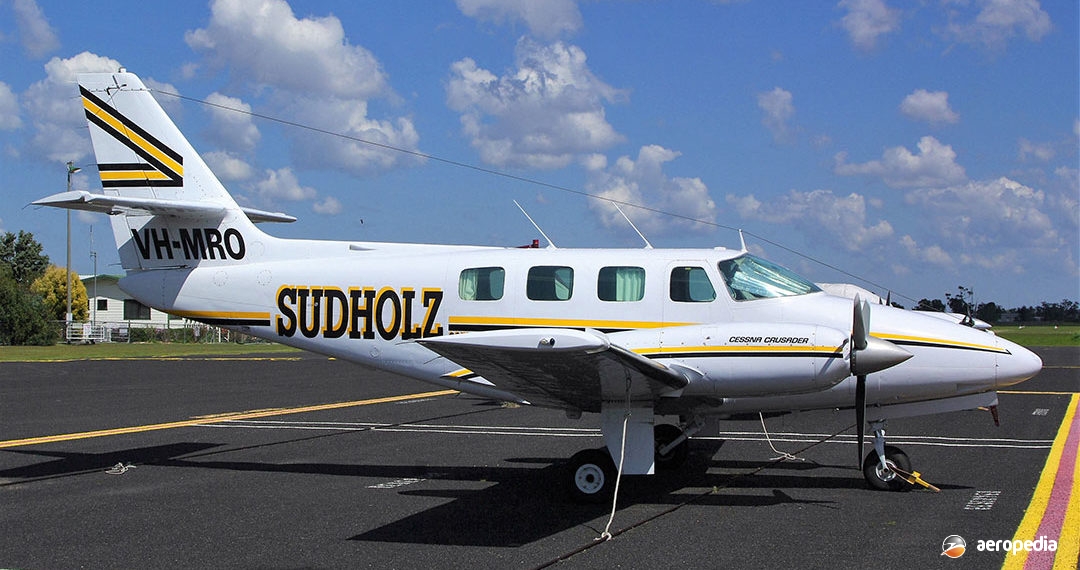Photograph:
Cessna T303 Crusader VH-MRO (c/n 30300041) at Goondiwindi, QLD in August 2010 (David C Eyre)
Country of origin:
United States of America
Description:
Light twin-engine cabin monoplane
Power Plant:
Two 186 kw (250 hp) Teledyne Continental TSIO-520-AE six-cylinder horizontally-opposed turbocharged air-cooled engines
Specifications:
- Wingspan: 11.84 m (38 ft 10 in)
- Length: 9.26 m (30 ft 4 in)
- Height: 3.93 m (12 ft 10¾ in)
- Wing area: 17.56 m² (189 sq ft)
- Max speed at 6,095 m (20,000 ft): 397 km/h (247 mph)
- Max continuous cruising speed at 3,050 m (10,000 ft): 333 km/h (207 mph)
- Initial rate of climb: 426 m/min (1,400 ft/min)
- Service ceiling: 7,620 m (25,000 ft)
- Range at max cruising speed with max fuel: 1,612 km (1,002 miles)
- Range with max load: 925 km (575 miles)
- Empty weight: 1,386 kg (3,056 lb)
- Loaded weight: 2,279 kg (5,025 lb)
History:
On 14 February 1978 Cessna produced a new light-weight twin-engined series of aircraft known as the Model 303. This aircraft was fitted with four seats and 119 kw (160 hp) engines, using bonded structures and a super-critical wing section. It was intended that the machine would replace the Model 310 in the Company’s range but, after further consideration, it was superseded by the Model T303 with six seats, 186 kw (250 hp) engines, and conventional construction. When first mooted, the Cessna Model 303 was named the Clipper but, after a short time, it became the Crusader as Pan American Airways had rights to that name.
The first of two prototypes was flown for the first time on 17 October 1979, and production commenced later in 1981. Various internal arrangements were available to meet customer demand, including club seating with writing tables mounted on the firewalls, or the seat backs of forward-facing seats.
The Model 303 seated six persons in individual seats in pairs and had a 20 cm (8 in) aisle in the middle. Baggage lockers in the nose, the wing and in the rear of the cabin permitted a total of 268 kg (590 lb) of luggage to be carried. This comprised 68 kg (150 lb) in the nose, 54.5 kg (120 lb) in each engine nacelle, and 91 kg (200 lb) in the rear of the cabin. Access to the cabin was via an airstair door on the left side. The wings were set at seven degrees dihedral, and were made in two sections: two outer panels and a double-spar centre-section, which ran between the engine nacelles and through the fuselage. The wing section was NACA 23017 at the root tapering to 23012 at the tip. Electrically- operated flaps were installed.
The engines were Teledyne Continental turbocharged, fuel-injected, counter-rotating units delivering 186 kw (250 hp) at 2,400 rpm, the left engine being a TSIO-520-E and the right engine being an LTSIO-520-AE, with the propellers being constant-speed fully-feathering units. Time between overhauls was 2,000 hours, and the fuel capacity was 587 litres (129 Imp gals). Cruising at 71 per cent power at 6,096 m (20,000 ft), at a speed of 368 km/h (229 mph), the range was 1,677 km (1,042 miles). Production of the Model 303 concluded in 1984 after 297 examples had been completed.
Nine examples have appeared on the Australian register and one in New Zealand. Two have survived in Australia, both Model T-303s, being VH-MRO (c/n T30300041) and VH-LMS (c/n T30300104), both based at Goondiwindi, QLD.

